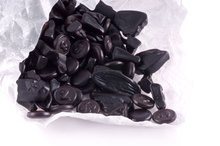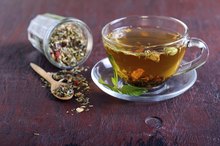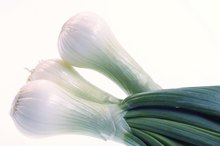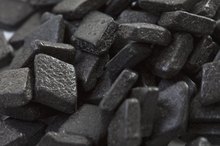Licorice Root & Smoking
According to the American Lung Association, more cancer-related deaths are attributed to lung cancer in the United States each year than breast, colon or prostate cancer, while about 13 million people are affected by chronic obstructive pulmonary disease, or COPD. What’s even more tragic is that these diseases are largely preventable. The good news is that quitting smoking now may reduce your risk. Certain supplements, such as licorice root, can complement a smoking cessation program. However, ask your doctor if you can safely use licorice root first, since there are several contraindications and drug interactions possible with this herb.
If you are experiencing serious medical symptoms, seek emergency treatment immediately.
Background
Licorice is the root of Glycyrrhiza glabra, a type of legume native to Europe and Asia. The flavor of licorice root is due to the presence of an aromatic compound called anethole, which is also found in fennel and anise. However, even though the latter impart a similar taste and aroma as licorice, they are not botanically related. Another compound in licorice root, glycyrrhizin, provides sweetness up to 50 times greater than sugar, which explains why the herb is also known as sweet root.
- Licorice is the root of Glycyrrhiza glabra, a type of legume native to Europe and Asia.
- Another compound in licorice root, glycyrrhizin, provides sweetness up to 50 times greater than sugar, which explains why the herb is also known as sweet root.
Traditional Use
Sarsaparilla Root Side Effects
Learn More
Licorice root has been used in herbal medicine for centuries to treat a variety of conditions. According to the University of Maryland Medical Center, licorice root is traditionally used as an expectorant and demulcent, which means to expel mucous and soothe irritation, respectively 1. As such, it is commonly used to treat cough associated with upper respiratory disorders, such as asthma and bronchitis. Other applications for licorice root include gastrointestinal complaints, such as acid reflux and peptic ulcers. However, these conditions are treated with a modified extract of the herb called deglycyrrhizinated licorice, or DGL, in which he glycyrrhizin content has been removed.
- Licorice root has been used in herbal medicine for centuries to treat a variety of conditions.
- According to the University of Maryland Medical Center, licorice root is traditionally used as an expectorant and demulcent, which means to expel mucous and soothe irritation, respectively 1.
Effectiveness
While there is no clinical evidence to support the use of licorice root to stop smoking, anecdotal evidence does exist. However, there are different schools of thought on how licorice helps. The most common theory held by modern herbalists is that licorice root enhances adrenal function because glycyrrhizin has a chemical structure similar to that of corticosteroid hormones produced by the adrenal glands. Smoking puts stress on the adrenal glands to release harmful substances, such as adrenaline, which can have adverse effects on the heart, blood vessels and blood sugar levels.
James A. Duke, Ph.D., a herbal expert and former three-pack-a-day smoker, suggests that chewing or sucking on a piece of raw licorice root might help to satisfy the oral cravings many smokers experience 2. In fact, in his book “The Green Pharmacy Herbal Handbook," he states, “If I were still a smoker, I'd give this one a try. 2”
- While there is no clinical evidence to support the use of licorice root to stop smoking, anecdotal evidence does exist.
- The most common theory held by modern herbalists is that licorice root enhances adrenal function because glycyrrhizin has a chemical structure similar to that of corticosteroid hormones produced by the adrenal glands.
Availability
High Potassium & Black Licorice
Learn More
Licorice root is sold as a dietary supplement. Preparations are available in capsule form and as a tincture and liquid extract standardized to contain 20 percent glycyrrhizinic acid. DGL is available as a liquid extract and chewable tablet.
Safety Considerations
Licorice root should not be taken longer than six weeks. High doses or long-term use of glycyrrhizinic acid may cause potassium depletion, high blood pressure, edema and pseudoaldosteronism, a condition characterized by sensitivity to adrenal hormones. Do not use licorice root if you are pregnant, nursing, or have a history of diabetes, hypertension or heart, liver or kidney disease. Licorice root may increase the effects of heart and diabetes medications, ACE inhibitors, diuretics and corticosteroids. Consult your health care practitioner before using this herb if you have a chronic condition or are taking other medications.
- Licorice root should not be taken longer than six weeks.
- Do not use licorice root if you are pregnant, nursing, or have a history of diabetes, hypertension or heart, liver or kidney disease.
Related Articles
References
- University of Maryland Medical Center: Licorice
- “The Green Pharmacy Herbal Handbook”; James A. Duke, Ph.D.; 2000
- NIH National Center for Complementary and Integrative Health. Licorice root. Updated December 1, 2016.
- Raveendra KR, Jayachandra, Srinivasa V, et al. An extract of glycyrrhiza glabra (GutGard)alleviates symptoms of functional dyspepsia: a randomized, double-blind, placebo-controlled study. Evidence-Based Complementary and Alternative Medicine. 2012;2012:1-9. doi:10.1155/2012/216970
- Messier C, Epifano F, Genovese S, Grenier D. Licorice and its potential beneficial effects in common oro-dental diseases. Oral Dis. 2012;18(1):32-39. doi:10.1111/j.1601-0825.2011.01842.x
- Shi Q, Hou Y, Yang Y, Bai G. Protective effects of glycyrrhizin against β2-adrenergic receptor agonist-induced receptor internalization and cell apoptosis. Biol. Pharm. Bull. 2011;34(5):609-617. doi:10.1248/bpb.34.609
- Tsao S, Yin M. Antioxidative and antiinflammatory activities of asiatic acid, glycyrrhizic Acid, and oleanolic acid in human bronchial epithelial cells. J. Agric. Food Chem. 2015;63(12):3196-3204.
- Zhao H, Zhang X, Chen X, et al. Isoliquiritigenin, a flavonoid from licorice, blocks M2 macrophage polarization in colitis-associated tumorigenesis through downregulating PGE2 and IL-6. Toxicology and Applied Pharmacology. 2014;279(3):311-321. doi:10.1016/j.taap.2014.07.001
- Nahidi F, Zare E, Mojab F, Alavi-Majd H. Effects of licorice on relief and recurrence of menopausal hot flashes. Iranian Journal of Pharmaceutical Research: IJPR. 2012;11(2):541-8.
- Hajiaghamohammadi AA, Zargar A, Oveisi S, Samimi R, Reisian S. To evaluate of the effect of adding licorice to the standard treatment regimen of helicobacter pylori. The Brazilian Journal of Infectious Diseases. 2016;20(6):534-538. doi: 10.1016/j.bjid.2016.07.015
- Irani M, Sarmadi M, Bernard F, Ebrahimi Pour GH, Shaker Bazarnov H. Leaves antimicrobial activity of Glycyrrhiza glabra L. Iranian Journal of Pharmaceutical Research: IJPR. 2010;9(4):425-8.
- Penn State Hershey Milton S. Hershey Medical Center. Licorice.
- Omar HR, Komarova I, El-Ghonemi M, et al. Licorice abuse: time to send a warning message. Therapeutic Advances in Endocrinology. 2012;3(4):125-138. doi:10.1177/2042018812454322
- Räikkönen K, Martikainen S, Pesonen A, et al. Maternal licorice consumption during pregnancy and pubertal, cognitive, and psychiatric outcomes in children. Am J Epidemiol. 2017;185(5):317-328. doi:10.1093/aje/kww172
- Consumer Reports. Food and drug interactions you need to know about. Updated November 4, 2018.
- Winchester Hospital. Library. Updated April 11, 2011.
- Consumer Reports. How to choose supplements wisely. Updated October 30, 2019.
- FDA. Black licorice: Trick or treat? Updated November 6, 2017.
Writer Bio
Karyn Maier is a seasoned columnist and feature writer. Since 1992, her work has appeared in Mother Earth News, The Herb Quarterly, Better Nutrition and in many other print and digital publications. She is also the author of five books, and is published in six languages.









